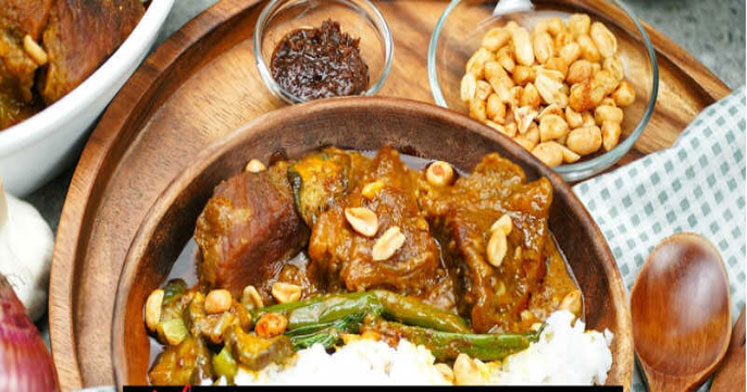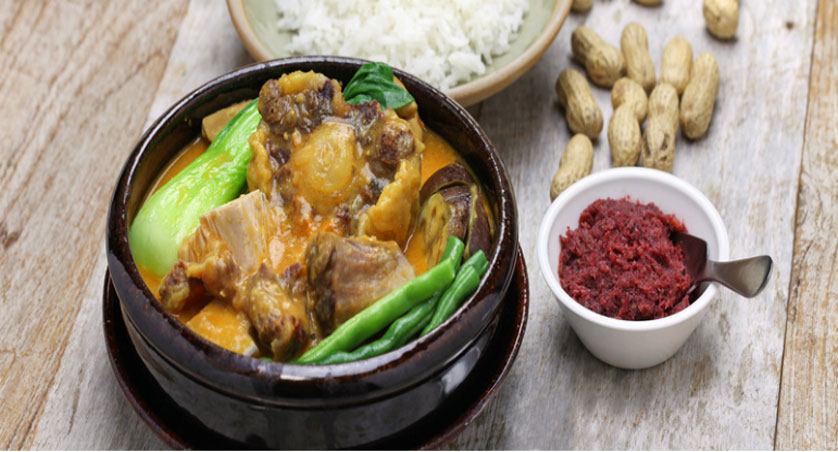What You Need To Know About The Fascinating History Of Kare-Kare
Feb 14, 2023 By Marie White
Kare-kare is a traditional Filipino stew made with meats such as oxtail, tripe, beef, and a rich peanut sauce. It is a staple dish in Filipino cuisine and is often served during special occasions and gatherings. The origins of Kare-kare need to be clarified, but it is believed to have been influenced by indigenous Filipino dishes and the cuisine of the Philippines' Spanish colonizers. The name "Kare-Kare" is thought to come from the word "curry," reflecting its spicy and flavorful profile. The dish is usually served with steamed rice and is typically accompanied by various dipping sauces and condiments, such as bagoong, a fermented shrimp paste. Over time, Kare-Kare has become a staple of Filipino cuisine and is enjoyed by people of all ages and backgrounds. Despite its long history, Kare-kare continues to evolve, with modern interpretations incorporating new ingredients and cooking techniques.
Origins

The origins of Kare-kare need to be better documented, but it is believed to have been influenced by indigenous Filipino dishes and the cuisine of the Spanish colonizers. The combination of meat, peanuts, and spices that make up Kare-kare is inspired by the flavors of traditional Filipino dishes. In contrast, the use of peanuts as a thickener for the sauce is believed to have been influenced by Spanish cuisine. The name "Kare-Kare" is thought to come from the word "curry," reflecting its spicy and flavorful profile.
Over time, Kare-Kare has become a staple of Filipino cuisine and is enjoyed by people of all ages and backgrounds. Despite its long history, Kare-kare continues to evolve, with modern interpretations incorporating new ingredients and cooking techniques. Today, Kare-kare remains integral to Filipino cuisine and is often served during special occasions and gatherings.
While the exact origins of Kare-kare may never be known, its place in Filipino cuisine is secure. The dish's unique blend of flavors and aromas continues to captivate people, making it a staple of Filipino culture. Whether enjoyed at home or in a restaurant, Kare-kare will surely provide a memorable culinary experience for all who try it.
Traditions And Significance
Kare-Kare has become a staple of Filipino cuisine and is enjoyed by people of all ages and backgrounds. It is typically served during special occasions and gatherings, such as holidays, birthdays, and other celebrations. The dish is usually served with steamed rice and is accompanied by various dipping sauces and condiments, such as bagoong, a fermented shrimp paste. Combining the rich and flavorful peanut sauce with the tender meats creates a dish that is both filling and satisfying.
Kare-kare is also an essential part of Filipino culture, reflecting its diverse history and unique blend of indigenous and colonial influences. The dish is a symbol of the Philippines' rich culinary heritage and is often enjoyed by families and friends to bring people together.
In recent years, Kare-Kare has gained popularity outside the Philippines, with many discovering its unique flavor profile and rich cultural history. Despite its growing popularity, Kare-kare remains an integral part of Filipino cuisine, continuing to be enjoyed by generations of Filipinos and those worldwide who appreciate its unique and delicious flavor.
Modern Interpretations

Kare-kare is a traditional Filipino stew that has been enjoyed for generations. While the dish has remained popular, it has evolved with new ingredients, cooking techniques, and flavor profiles. In this article, we will explore some modern interpretations of Kare-kare and how they are changing how people experience this iconic dish.
One of the most notable changes in modern interpretations of Kare-kare is the addition of new ingredients. Some modern variations of Kare-kare may include a variety of vegetables, such as eggplant, bok choy, or string beans, to add additional flavors and textures to the dish. This allows for a more diverse and exciting eating experience and provides a more balanced meal. Additionally, some modern versions of Kare-kare may incorporate alternative meats, such as chicken or pork, instead of the traditional oxtail, tripe, and beef. This not only allows for a more budget-friendly option but also provides new flavor profiles to the dish.
Another way that modern interpretations of Kare-kare are changing is through cooking techniques. Traditional Kare-kare is often cooked by simmering the meats and vegetables in a peanut sauce until they are tender and flavorful. However, modern interpretations of Kare-kare may incorporate slow-cooking methods, such as slow roasting or simmering, to enhance the flavor and tenderness of the meats. Additionally, other arrangements may use techniques like pressure cooking, grilling, or stir-frying to create an entirely different experience for the diner. These cooking techniques allow for a faster preparation time and a more versatile flavor profile.
One of the most exciting ways modern interpretations of Kare-kare are changing is through fusion cuisine. Many restaurants and chefs are combining the traditional flavors of Kare-kare with other cuisines, such as Chinese, Indian, or Mediterranean, to create unique flavor profiles. This provides a new and exciting dining experience and allows for more diverse and multicultural cuisine. Some famous examples of fusion Kare-kare include Kare-kare fried rice, Kare-kare tacos, and Kare-kare ramen.
Conclusion
Kare-kare is a dish with a rich history and cultural significance in the Philippines. Its combination of meat, peanut sauce, and spices has made it a beloved word that continues to be enjoyed by Filipinos today. Despite its long history, Kare-kare continues to evolve, adding new ingredients and cooking techniques to the traditional recipe. Today, Kare-kare remains integral to Filipino cuisine and is often served during special occasions and gatherings. Whether prepared in a traditional or modern way, Kare-kare is a dish that continues to fascinate and delight people with its unique blend of flavors and aromas. Whether enjoyed at home or in a restaurant, Kare-kare will surely provide a memorable culinary experience for all who try it.
-
 Sep 01, 2023
Sep 01, 2023Best Key Lime Cake Recipe For A Zesty Summer Treat
Escape to tropical flavors with this refreshing Key Lime Cake recipe! Learn how to make it at your home by following certain instructions.
-
 Sep 04, 2023
Sep 04, 2023Get To Know Tha Delicious, Healthy and Easy Baked Eggs Recipes
Do you want to try out easy-baked eggs? Then, it would help if you gave it a shot, as it is quick and simple to make. Just add a few ingredients and bake the eggs
-
 Sep 09, 2023
Sep 09, 2023The Secret to Crispy Pepperoni Edges and Maximum Flavor
Are you looking to level up your pepperoni pizza? Here's a quick and simple trick in this article: make your perfectly crispy pepperoni edges, making it even more delicious.
-
 Sep 03, 2023
Sep 03, 2023What Are The Kenji's Favorite Recipes In 2023
Chef J. Kenji López-Alt is a food scientist with a stellar culinary reputation. There are some of the most famous Kenji's recipes mentioned here.
